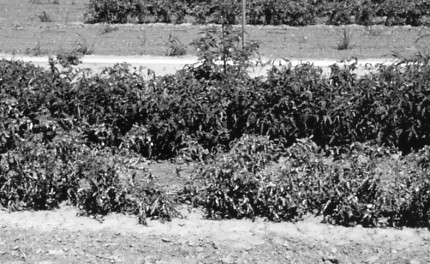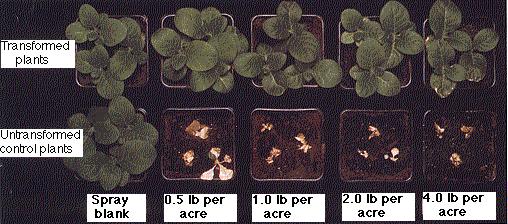
| Index to this page |
Progress is being made on several fronts to introduce new traits into plants using recombinant DNA technology.
The genetic manipulation of plants has been going on since the dawn of agriculture, but until recently this has required the slow and tedious process of cross-breeding varieties. Genetic engineering promises to speed the process and broaden the scope of what can be done.
In this respect, it is easier to produce transgenic plants than transgenic animals.
Milled rice is the staple food for a large fraction of the world's human population. Milling rice removes the husk and any beta-carotene it contained. Beta-carotene is a precursor to vitamin A, so it is not surprising that vitamin A deficiency is widespread, especially in the countries of Southeast Asia.
The synthesis of beta-carotene requires a number of enzyme-catalyzed steps. In January 2000, a group of European researchers reported that they had succeeded in incorporating three transgenes into rice that enabled the plants to manufacture beta-carotene in their endosperm (giving them a golden color). Over 2 decades later (2021), one country, the Philippines, has given approval for the planting of this "Golden Rice".
| Link to illustrated discussion of Bacillus thuringiensis. |
Genes that provide resistance against plant viruses have been successfully introduced into such crop plants as tobacco, tomatoes, and potatoes.
| Tomato plants infected with tobacco mosaic virus (which attacks tomato plants as well as tobacco). The plants in the back row carry an introduced gene conferring resistance to the virus. The resistant plants produced three times as much fruit as the sensitive plants (front row) and the same as control plants. (Courtesy Monsanto Company.) |  |
Questions have been raised about the safety — both to humans and to the environment — of some of the broad-leaved weed killers like 2,4-D. Alternatives are available, but they may damage the crop as well as the weeds growing in it. However, genes for resistance to some of the newer herbicides have been introduced into some crop plants and enable them to thrive even when exposed to the weed killer.
 |
| Effect of the herbicide bromoxynil on tobacco plants transformed with a bacterial gene whose product breaks down bromoxynil (top row) and control plants (bottom row). "Spray blank" plants were treated with the same spray mixture as the others except the bromoxynil was left out. (Courtesy of Calgene, Davis, CA.) |
A large fraction of the world's irrigated crop land is so laden with salt that it cannot be used to grow most important crops. [Discussion]
However, researchers at the University of California Davis campus have created transgenic tomatoes that grow well in saline soils. The transgene was a highly-expressed sodium/proton antiport pump that sequestered excess sodium in the vacuole of leaf cells. There was no sodium buildup in the fruit.
This term is used (by opponents of the practice) for transgenes introduced into crop plants to make them produce sterile seeds (and thus force the farmer to buy fresh seeds for the following season rather than saving seeds from the current crop).
The process involves introducing three transgenes into the plant:Because the toxin does not harm the growing plant — only its developing seeds — the crop can be grown normally except that its seeds are sterile.
The use of terminator genes has created much controversy:| These are discussed in a separate page. Link to it. |
The genes for proteins to be used in human (and animal) medicine can be inserted into plants and expressed by them.
Advantages:Corn is the most popular plant for these purposes, but tobacco, tomatoes, potatoes, rice and carrot cells grown in culture are also being used.
Some of the proteins that have been produced by transgenic crop plants:The introduction of transgenic plants into agriculture has been vigorously opposed by some. There are a number of issues that worry the opponents. One of them is the potential risk of transgenes in commercial crops endangering native or nontarget species.
Examples:
To date, field studies on Bt cotton and maize show that the numbers of some nontarget insects are reduced somewhat but not as much as in fields treated with insecticides.
Another worry is the inadvertent mixing of transgenic crops with nontransgenic food crops. Although this has occurred periodically, there is absolutely no evidence of a threat to human health.
Despite the controversies, farmers around the world are embracing transgenic crops. Currently in the United States over 80% of the corn, soybeans, and cotton grown are genetically modified (GM) — principally to provide
| Welcome&Next Search |